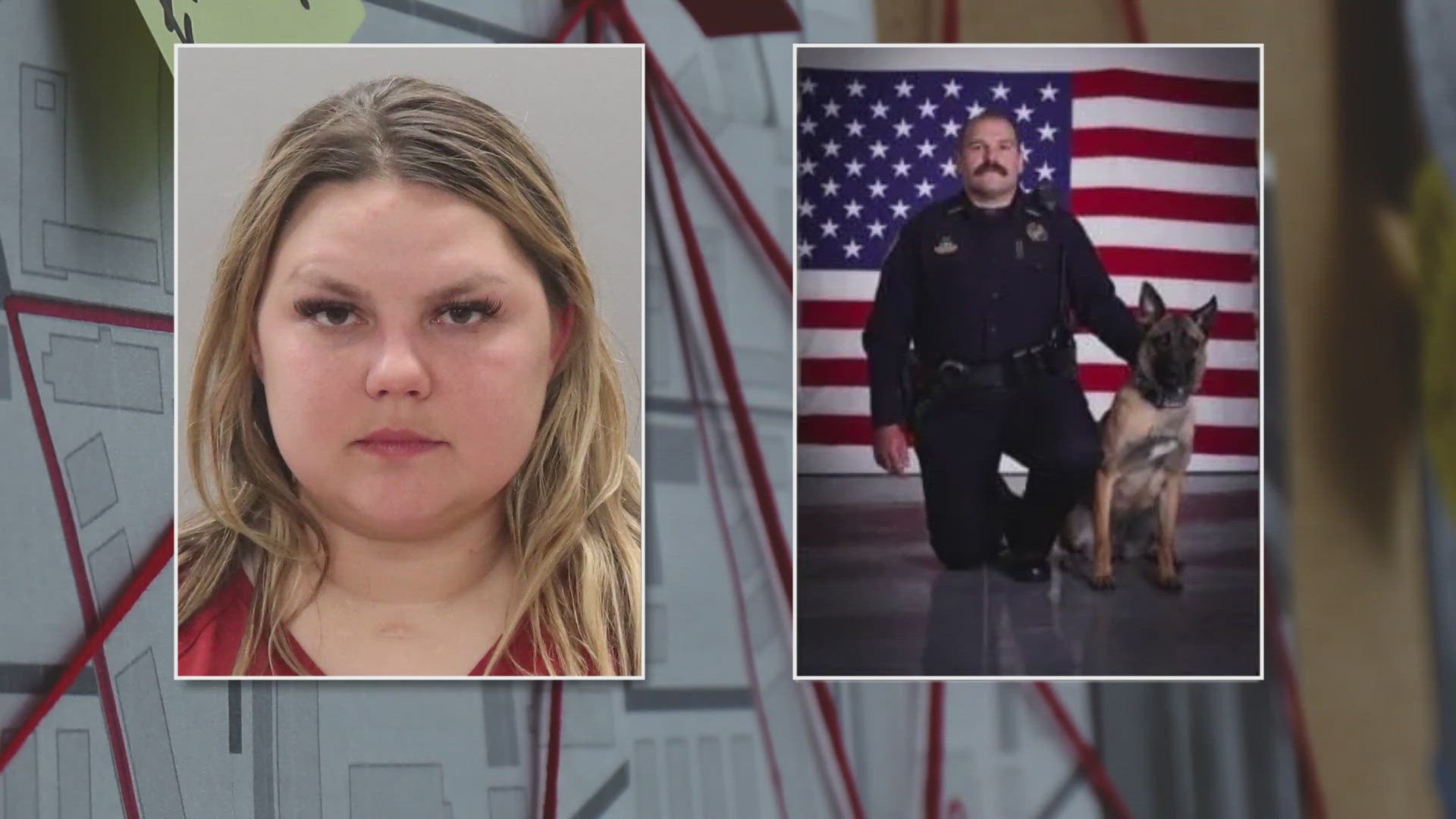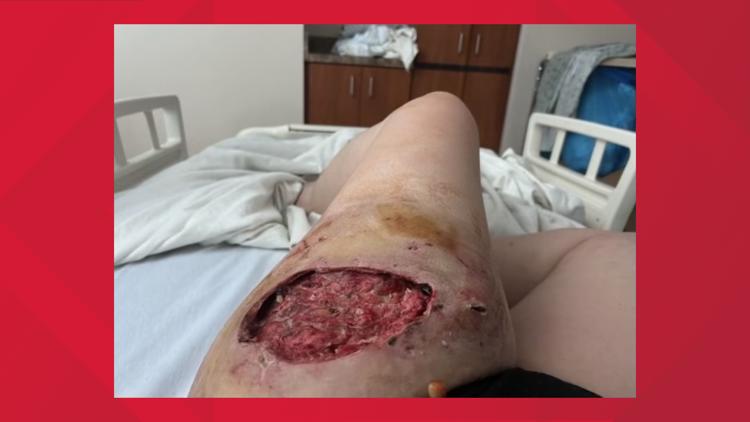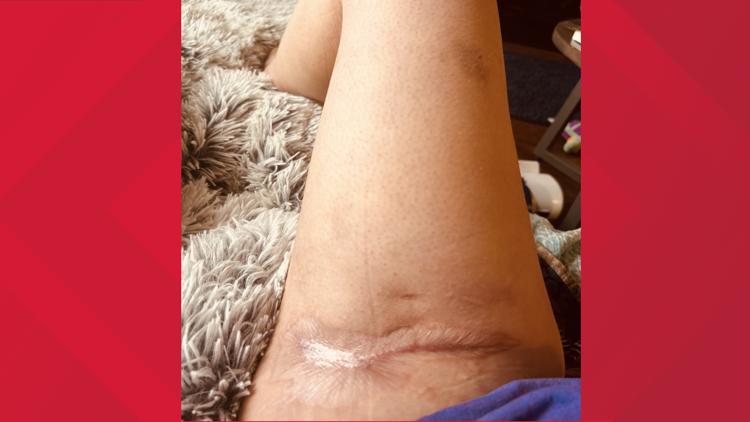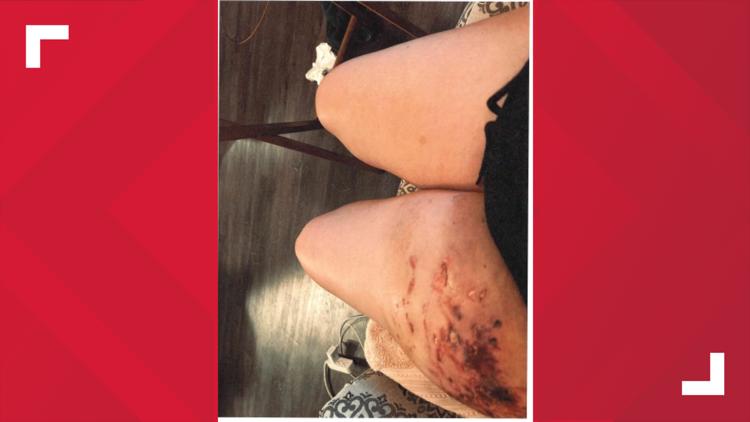KNOXVILLE, Tenn. — Editor's Note: This story contains graphic details and pictures. Discretion is advised.
Hundreds of thousands of dollars in medical bills, an abscess, two surgeries, and two skin grafts. All the result of a nearly 2-minute dog bite by a Knox County Sheriff's Office K-9.
Ashley Gragg, 29, suffered that bite.
On March 14, 2024, KCSO Deputy Kyle Bothof responded to a call after someone reported seeing a woman stealing packages and decorations from a West Knox County neighborhood.
KCSO camera footage showed Bothof confronting Gragg that night in March. Her car's description and license plate exactly matched what the witness had provided.
Officer Bothof's initial confrontation with Gragg quickly turned into him pulling his gun on her after she turned back towards her car door. Bothof eventually released his K-9, Dolly.
As a result of Dolly's bite, Gragg has undergone several surgeries. She's racked up hundreds of thousands of dollars in medical bills. Attorney Lance Baker says they intend to sue the county.
To understand what happened to Gragg, 10Investigates looked into Bothof's personnel file, KCSO use of force reports and policies and spoke with a nationally recognized expert about the bodycam footage.
KCSO has not disciplined the deputy, who has received positive performance reviews in the past and has been commended for his work as a K-9 officer.
NIGHT OF THE BITE
In the bodycam footage, Gragg acted confused when the deputy asked her about the thefts.
Bothof explained she was being detained for possible theft. She questioned what he was talking about. She then told him she had to go babysit for a friend and that he could come to her house later to talk, to which he said no.
Eventually, she turned to her car door and things escalated.
"Don't go back in the car. Don't go back in the f----- car!" Bothof said to Gragg, with his gun pulled.
"Don't—don't hurt me," Gragg said. "Hey, please don't hurt me."
Bothof then approached her and attempted to put her in handcuffs. The two struggled against the side of Gragg's cruiser for about a minute, and Bothof eventually took Gragg to the ground.
Bothof radioed he was "Code J," meaning he wasn't in distress. He confirmed that at a preliminary hearing for Gragg in August.
He also testified that there was no indication from dispatch that she was armed and dangerous. However, he added that when Gragg opened her car door, he didn't know what was inside.
"I'm putting you in handcuffs, so stop resisting or you're gonna put on the ground—or I can let my dog out of the car," Bothof told Gragg.
Throughout the nearly two-hour bodycam footage, Bothof told Gragg to stop resisting over 20 times. He told her he would release his K-9 several times.
Bothof released Dolly. Later in the bodycam footage, he told other officers it was the first time he'd released her from his car remotely. A controller can be seen in Bothof's hand in the footage.
The dog clamped down on Gragg's leg for almost 40 seconds before Bothof called her off.
But the dog held on. She stayed latched to Gragg's leg for about another 40 seconds. Bothof repeatedly yelled at Dolly to let go. By this time in the footage, another officer had already arrived at the scene and was on top of Gragg, putting her in handcuffs.
10Investigates: K-9
Later in the bodycam footage, Bothof told another deputy he thought Dolly had thrown up on Gragg. But in his August testimony, he clarified it was actually Gragg's leg tissue that had been in the dog's mouth.
Bothof found packages and porch decorations in the back of Gragg's car. He also found bottles of Jim Beam in the passenger seat.


Gragg was transported from the scene in an ambulance for treatment. Attorney Baker says she was given one dose of an antibiotic at the hospital. She was supposed to receive another round 12 hours later, he says, but he hasn't been able to verify she received any medication at the Knox County Detention Center.
Baker adds he hasn't been able to verify if Gragg was seen by medical staff. She was never told she needed to fill a prescription after leaving jail, he says.
Within days, Gragg developed an abscess in the dog bite wound. She's since had several surgeries, a wound vac placement and several skin grafts. Baker says her medical bills add up to hundreds of thousands of dollars.
KCSO RECORDS, EXPERT CASE ANALYSIS
10Investigates asked KCSO several times if anyone, including Bothof, would be willing to speak on camera. We also asked if they thought the March incident was a proper use of force.
KCSO declined to answer because Gragg's case is still before a grand jury.
WBIR showed a nationally recognized expert, Ed Obayashi, the bodycam video.
Obayashi is a deputy sheriff and policy adviser for the Modoc County Sheriff's Office in California. He advises law enforcement agencies across the country about use-of-force protocols. Prosecutors and defense attorneys regularly turn to him for case analysis.
He said he has serious concerns about the way Gragg's arrest was handled.
"I see no attempts at de-escalation on the part of the deputy. Immediately, he takes her to the ground," Obayashi said. "This would appear to be a self-fulfilling case of force that could have otherwise been avoided."

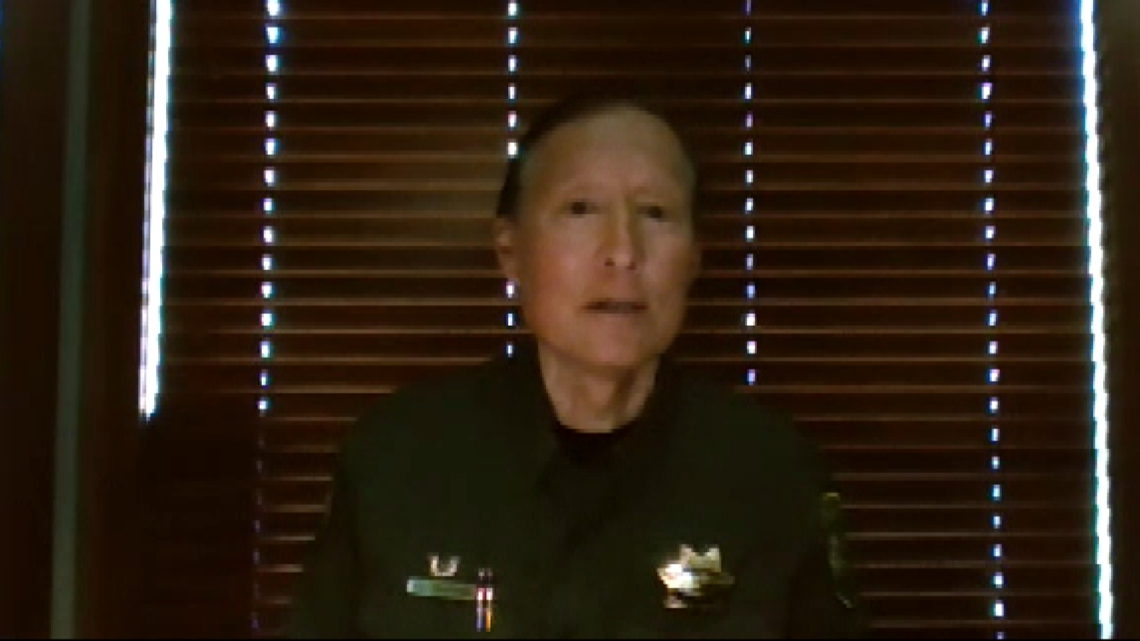
At the August hearing, Bothof said Gragg was actively resisting. Obayashi disagreed.
"She's clearly not threatening the officer to the degree that would justify the deployment of a dangerous, inherently dangerous weapon, such as a canine," Obayashi said.


KCSO's use of force policy defines active resistance as physically evasive movements to interfere with the deputy, like bracing, tensing, pulling away, flight or pushing.
Obayashi doesn't think Gragg was actively resisting. "The law differentiates between passive resistance, minor, inconsequential refusal to comply, versus active resistance, where an individual is actively assaulting an officer," he said.
Obayashi says there's no "set" definition of active resistance and that department policies are often vague. It can depend on how a court defines it.
Obayashi says the level of resistance needs to match the level of force used by the officer.
"There has to be a reasonable belief on the part of the officer that the individual is presenting a threat to his or her safety or others. It's clear that there isn't [in this case]," Obaysahi said. "The female makes no verbal threats. She doesn't strike the police K-9. She doesn't make any attempt to assault the officer."
In that August hearing, Bothof says the moment when he pulled his gun on Gragg and yelled was an attempt to de-escalate. KCSO's use of force policy defines de-escalation as a decrease in the severity of force as a response to a decrease in the level of resistance.
We reviewed Bothof's personnel file. He joined the force in 2015 and was named Officer of the Month in January 2021 and 2023, and K-9 Officer of the Year in 2022. His superiors say errors in his work "are extremely rare or nonexistent," that he "uses good judgment" and is "very safety conscious."
We requested every use of force report involving Dolly from the last three years. Every time she's released on the job, Bothof has to file a report. Records show in that time period, she's been released to subdue someone 56 times and bitten someone four times.
We asked KCSO for details about those incidents to see when Dolly had been used and the suspect willingly surrendered. Every report we requested but two were completely redacted. KCSO said it's because they're still in open court or they're another agency's case.


We also asked to speak with Gragg. Because of her criminal case, attorney Baker declined to speak directly but offered a statement. He said:
“Ms. Gragg has been horribly victimized for the second time in her life by someone we pay to know better. It is a bad case to prosecute. If Ms. Gragg didn’t have an excessive force claim under civil rights laws against both the county and the officer(s) involved for the severe injuries she suffered at their hands, we wouldn’t even be having a conversation about a criminal prosecution, it would have already been resolved. The video speaks for itself. People can make up their own minds about whose safety was threatened . . . an unarmed 5-foot-tall girl with a prior brain injury or a 260-pound man armed with a Taser, a .40 Glock firearm, a $15,000 K-9, and thousands of dollars worth of training. That’s what we’re likely going to be asking the juries who will be hearing these cases to do. Needless to say, we’re confident about our position.”
Baker explained that Gragg was hit by a car in a parking lot in 2020 and suffered a traumatic brain injury. After the impact, her Glasgow Coma Scale—a tool used to measure one's level of consciousness after a brain injury—was 3/15, which is the worst score possible, he said.
A score of 15 is a normal level of consciousness. Gragg underwent an emergency craniotomy. She did extensive rehabilitation at the Shepherd Center in Georgia and outpatient therapy at the Patricia Neal Rehab Center, Baker said.
Baker says he anticipates Gragg filing suit against the county. Gragg's criminal case was bound over to a grand jury in August. If she's indicted, she'll have a trial.
"She's in good spirits considering everything she has went through but is still suffering from her injuries and the totality of what happened," Baker said.
Obayashi questioned why Bothof didn't hold off on releasing the dog and wait for backup that night in March.
"You have to analyze these use of force incidents in the context of what type of resistance was being demonstrated by the subject," Obayashi said. "Very few individuals I know—this is common sense—would remain completely passive when being bitten by a dog. A dog bite can go through sheet metal."

